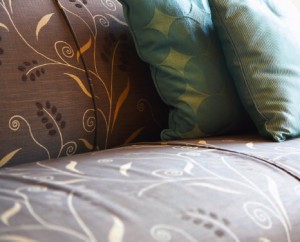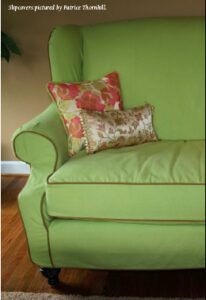QUICK SWITCH Lighten Your Look With Slipcovers
 Summertime as a child meant warm days filled with spontaneity and freedom. As adults, something inside of us still feels that summertime yearning for a change of pace. In our homes, nothing can foster this change like a quick switch of color. One of the most dramatic ways to escape the winter doldrums and plunge into summer is to swap out some of the fabrics in your home using of slipcovers.
Summertime as a child meant warm days filled with spontaneity and freedom. As adults, something inside of us still feels that summertime yearning for a change of pace. In our homes, nothing can foster this change like a quick switch of color. One of the most dramatic ways to escape the winter doldrums and plunge into summer is to swap out some of the fabrics in your home using of slipcovers.
Where do I start?
Slipcovers are the perfect perk for a room, and custom slipcovers are easily attainable here in the Roanoke Valley area. Kathy Spark, owner of Roanoke’s Accents on Windows, suggests changing fabrics seasonally, or at least two times a year, to give rooms a change of mood.
Linda Roudabush, co-owner of Sew Unique, equates slipcovers to apparel. “They are like clothes. You can change them, and it gives the house a different personality,” she says. She and husband Jeff offer a few pointers for those considering slipcovers for their décor. “The first step is to decide the reason why you want a slipcover,” says Jeff Roudabush. Whether a homeowner is looking for a seasonal change for an elegant piece, or something washable for the grandchildren affects the decision-making process. Deciding how often a slipcover will be cleaned also influences the choice of fabric. If you’re willing to launder the cover yourself, fabrics such as denim and duckcloth are good choices, yet more options are available if you’re open to dry cleaning. “You can do whatever you wish as far as the fabric goes. It just depends on what your lifestyle is and the amount of washing you will do,” he says.
Earle Goodwin of New Day Company believes that “slipcovering is an art in itself.” He outlines several benefits of slipcovers—one of which is extending the life of the original fabric on the upholstered piece. Achieving a “different look aesthetically” is another benefit to slipcovering a piece of furniture, he says. “Slipcovering is like getting two pieces for the price of one,” he points out. Goodwin has been working with tailor Ahmet Ramadan—an experienced craftsman who has made custom covers for the elite of New York City—for almost 40 years.
Is this piece worth slipcovering?
Deciding what furniture to slipcover can put homeowners in a quandary. The piece’s overall condition is very important, and a simple inspection can tell you whether you should invest the time and money into slipcovering it. If it is badly soiled, the original material should be thoroughly cleaned, since old stains can leech through to the new fabric. Goodwin offers this advice: “If you put a slipcover on a ‘tired’ chair, it will change the look, but it will not improve the condition of the basic chair.” He also says you shouldn’t slipcover anything that doesn’t have “a good foundation.” A heavy frame is a good indicator of quality, while more lightweight pieces with frames constructed of softer woods may not be worth the investment of a slipcover.
A custom-fitted slipcover adds much more panache than a ready-made store-bought cover, and it allows for more creative expression. Although one-size-fits-all covers are a quick solution, they can be bulky and leave the homeowner puzzled over ties, pins and elastic. Custom pieces allow for the true shape of the piece to show through, and skirts and piping can be added for a more unique look. Custom work also eliminates the worries about the cover slipping or not fitting properly. Roudabush adds, “If a slipcover is done right, it looks like upholstery.”
Many slipcover tailors offer an in-house variety of textiles, or customers can provide fabric from their own sources. Prewashing fabric is a wise idea to allow shrinkage before the piece is constructed.
A custom tailor will also see the project through from start to finish. “I go to your home, bring fabrics, and then do the measuring, quoting and ordering,” explains Spark. The Roudabushes also use a similar process, in which they take measurements and cut the fabric at the client’s home. The slipcover is then assembled in their workspace, so that the client does not have to be without seating pieces while the cover is being constructed.
Since a sofa plays a considerable role in the look and feel of a space, switching it up with a slipcover is one of the most impactful decisions you can make. But many other pieces can be slipcovered and coordinated as well. Spark’s clients are able to order slipcovers, bedding, pillows and accessories to coordinate with their décor. Her business also offers a line of “Couture Covers” for Parson’s chairs—versatile chairs suited to almost any room in your house. The base chair is around $145 and slipcovers start around $60. Spark says, “They give a nice, custom look, and there are many fabrics to choose from.”
To perk up wooden dining chairs, custom seat cushions are an easy, flexible option, and the entire chair can be measured and fitted for a custom cover as well. The seat of the chair can also be covered in a skirt of any length. To transform simple folding chairs, consider a slipcover that envelops the entire chair.
 Commissioning a Custom Cover
Commissioning a Custom Cover
If cost is a concern, remind yourself that you are actually extending the life of the piece’s fabric, as well as providing a whole new look—like having two pieces of furniture in one. The cost of custom slipcovers can vary tremendously because there are many variables: the fabric, the tailor, the form of the piece itself, the trims and details. To get an idea of what such a project might cost, however, consider this ballpark range: To slipcover an upholstered chair, you can expect to pay around $300 to $400 for labor, plus the cost of 8 to 10 yards of fabric. Sofas require around 15 to 20 yards of fabric with an approximate labor cost of $400 to $600, while loveseats require 10 to 15 yards of material with a construction cost of around $350 to $450. Adding details like decorative trim, skirts and piping will also affect the cost of the project.
Now that summer is here, all it takes is a little imagination and inspiration to transform your residence into a place that leaves the cold weather behind and welcomes the warmer weather’s bright sunny viewpoint into your home. With a few textile changes, your home will be welcoming and ready for the summer season.






